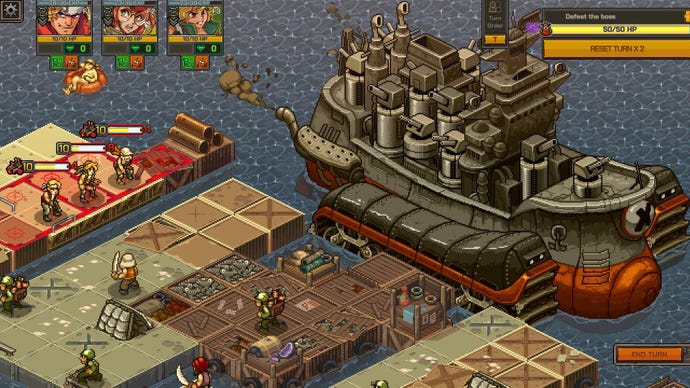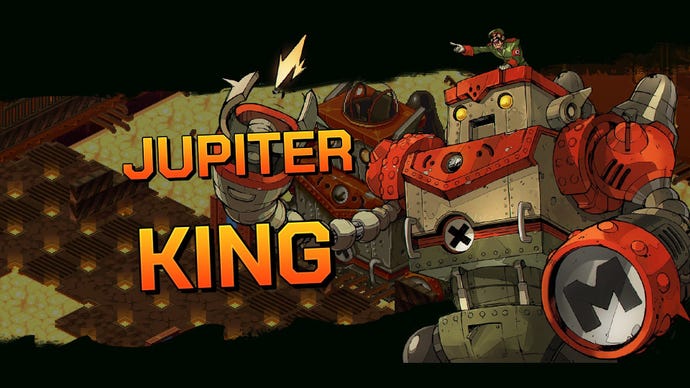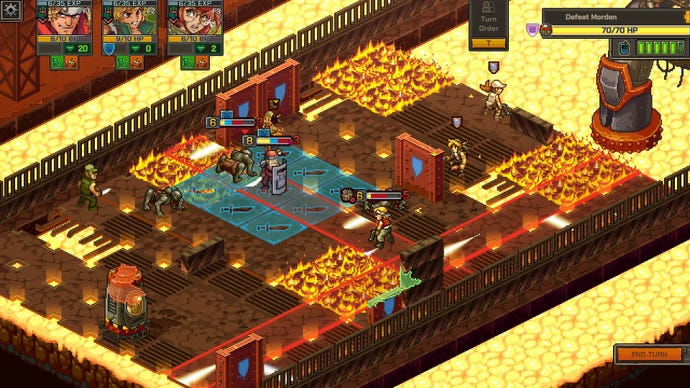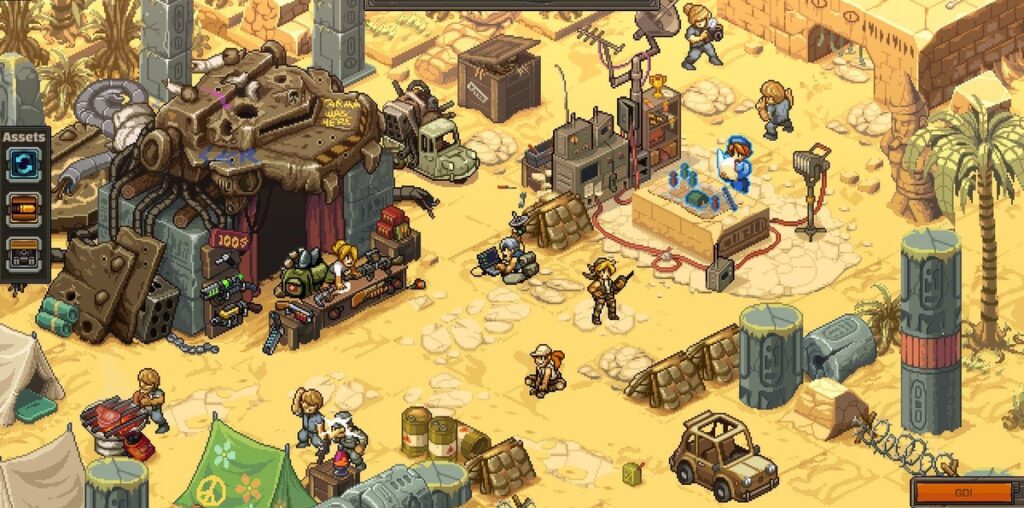I am a very casual enjoyer of Metal Slug games. I’ve never actually paid for one of these side-scrolling shoot ’em ups, except for all the countless coins I happily pumped into arcade machines as a child. To this day, if I see a rare glittering cabinet running one of these crunchy shmups, I will go ham for twenty or thirty minutes, and walk away satisfied that I have seen a lot of very good pixels. These games, I am convinced, were never really designed to be completed, but to be played exactly like this, as a coin-gobbling invitation to become a bandana-wearing sisyphus, a tiny Rambo pushing a bouncy, juddering tank up a hill occupied by cartoon nazis. You die a bunch and say: “ah, that was good.”
So what happens when you rearrange the molecules of this run and/or gun ’em up into an isometric turn-based strategy game? You get Metal Slug Tactics, an off-kilter nod to Into The Breach and other grid-based turn-takers, but secretly housing the aggressive notions of an unhinged pyromaniac. You still die a lot. And you still walk away feeling fairly happy about it.
Well, I did at least. It really depends on your tolerance for roguelikey restarts. As the team of Metal Sluggers you are sent to stop known mischief maker Morden (first name Donald), who is very classically up to no good. But it can be a tough war, and the conflict is designed to be restarted again and again, with new goodies getting unlocked as you slowly chip away at the list of weapons mods and nine-strong character roster.
Fights take place on griddy battlefields. You get three characters, each with their own weapon loadouts and special skills. Some tote lasers that can zap right through multiple enemies in a straight line. Others have devices that let you grab enemies by the hair and hoist them to a distant tile. Some characters throw grenades, allowing you to lob your painmakers over the top of your fellow freedom fighters without committing to friendly fire (you’ll be hitting your own troops a lot – it’s fine).
To the tactics fiends among us, it seems straightforward to begin with. Its similarities to Into The Breach in particular feel helpful in establishing what the game wants from you. You can undo movement as many times as you like, for example (provided you haven’t altered the environment by knocking down a crane or waking a mummified corpse). You also have two turn resets per battle. Meaning that if you mess up a manoeuvre with multiple troops, you can rethink it entirely.

But quickly you see that you’re expected to be a little more aggressive than your average tactical trouncer. Cover is sometimes helpful but staying still is not. You only generate “dodge” points by moving, basically granting extra protection from incoming fire by constantly changing position. And you only generate “adrenaline” points in the same way. These adrenaline points are needed to perform your more powerful special actions, like teleporting two enemies in a silly swaperoo, or chasing down a swordsman on a motorcycle.
Since moving around a lot is the only way you farm the points needed for these essential moves, it becomes a strong incentive to stay mobile. “Remember,” the game teaches you, “we always run and gun”. The stacking power of dodge and cover bonuses means you can get into some funny positions of power through scrappy and aggressive play, like being surrounded by melee attacking enemies on every side but still able to dodge each and every swing, then use your fiery jump boots to set everyone around you ablaze in a daring act of escape.
It’s also somewhat hard to get your head around, speaking as a traditionally tactical turtler. Battles are often replete with enemies – far more than you can feasibly handle – and you’re forced against your baddie-squashing instincts to play the objective. Your goal might be to only kill a handful of special targets. Or you might be asked to get two of your soldiers to a certain spot within three or four turns (the implication here is: which of your three troopers will make the best meat shield while the others escape?)




There is another layer to battlin’ that can help you out. Basically, if you arrange your troops so they all line up with the same enemy, then launch an attack with one of your fighters, the other two heroes will follow suit in a dogpiling act of “syncronization”. This too means more gritty decisions: which enemy should you work as a team to eliminate, and which should you pick off as individuals? Some enemies you’ll just disregard entirely, writing them off as lesser pests in a grander game of grenade tossing.
It’s an interesting extra layer that you’ll need to exploit to get out of most scrapes alive. But it’s also hard to physically plan, with a lot of moving into position just to check if a shot is viable, then undoing it and checking from another angle. I never felt like I truly got the hang of syncing up my attacks perfectly. In the end, I often just went with my gut out of impatience. I died a lot.
But not as much as Rumi, the suicidal trader that features in a few of the game’s difficult escort missions. These protective jaunts are among the roughest in the game, I found, along with other mission types that see you protecting miners from a gang of mummies that can kill in a single hit. It can be likewise annoying when an enemy reinforcement randomly falls in exactly a spot where it will do most damage next turn, scuppering well-laid last stands all because of a little randomness.

This is where the comparison with Into The Breach becomes unflattering. That masterpiece of turny tactics was set on such a small, finely tuned diorama, that each round became an almost-always solvable puzzle; a bit of kaiju chess. Your options for both movement and combat were limited, and each enemy had its upcoming attacks clearly signalled. It was just up to you to escape the checkmate.
Metal Slug Tactics doesn’t want to be so obvious, keeping most enemy movements to itself. This makes the elimination-style levels more open-ended, but it also makes the escort and protection missions unpredictable and irritating in the way escort missions so often are. You are not even told where Rumi, the gung-ho death-enjoyer, is going to move to next. I started avoiding these missions completely by choosing the simpler “kill stuff” missions, ignoring even the tastiest of rewards the game would dangle in front of me. Character XP, coins to buy weapon parts, instantly deployable tanks – none of it matters if you lose an entire run because a mummy chose to hit a miner insead of the explosive decoy dummy you put down nearby.
The world map sees you do all this fighting across various locales (Egyptian desert, Middle Eastern villages, South American jungles, and North American cities) each with enemy types and bosses that perform distinct attacks (and appearances which sadly adhere to the childish stereotypes Metal Slug has been running with since the 1990s, as Nic previously pointed out when he played the demo). Eventually, you hit the boss fights, which are roundly enjoyable and challenging wreck sessions in which huge patches of the map will become red with incoming fire, hot lava, or sandy destruction.

It really starts to come into its own when new characters are unlocked following successful runs. Knifey ninja Trevor can confuse enemies into attacking their own pals. Beefcake Clark throws enemies around, making it easier to line up synchronised shots. Nadia summons self-destructive robots that can cause a handy distraction but risk a lot of friendly fire damage.
They’re great additions. But it did feel like these characters are slow to appear thanks to the challenging nature of some missions. A slow drip of progression doesn’t feel sluggish in something like (again) Into The Breach, because few fights last long. But some battles in Slugtac can become drawn out, especially the boss battles, even with the handy “hold spacebar to fast forward” button. The repetitive radio chatter of your off-screen commander, Margaret, also slows things down considerably. For everything this game adds in mods, upgrades, character abilities, and unusual enemy tricks, it also clutters up the elegance and simplicity that makes the grid-based fighting of Into The Breach so compelling and tight.
But maybe I shouldn’t keep comparing this to Subset’s masterwork. Maybe we should instead compare it to other Metal Slug games. In that case, I almost prefer this incarnation of the pixel pistoleers. The arcade difficulty of those shooters was forged in the quarter-swallowing era in which games were difficult as a de facto means of extracting more coins from your little pockets. And as much as I like those twenty-minute sessions, I will never see these games through. Whereas the difficulty of a tough escort mission feels more true to the tactical genre of “end turn” button-pushing. Plus all the undos, resets, and pauseful pondering makes things more manageable, to the point where I have – shock horror – actually completed multiple runs.
I especially like how the arcade game’s soul has been transplanted not just in the art style but also the sound design. The character select screen yells each character’s name with the tinny echo of arcade enthusiasm. “Marco!” – “Fio!” – “Echo!” It is so married to its arcade roots that even the currency you use to unlock post-campaign upgrades is called “credits”. I’ve accrued a fistful of these digi-quarters. But you know what? I’m content with what I’ve played. Like a good Metal Slug game, I can happily walk away from it without seeing every last battlefield. I’m fully satisfied with the time and quarters I’ve already spent.

